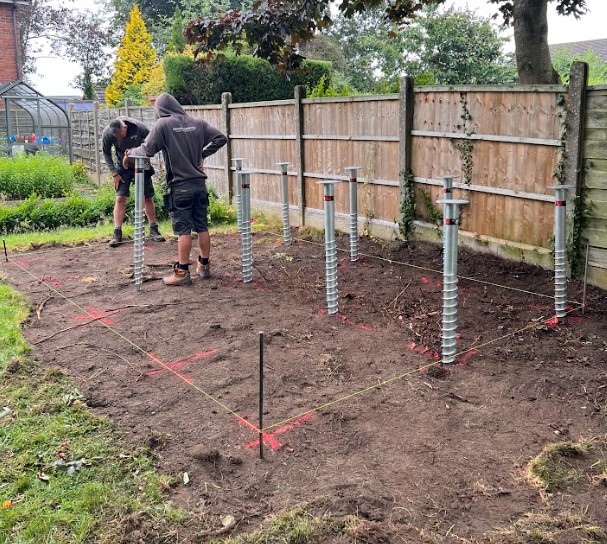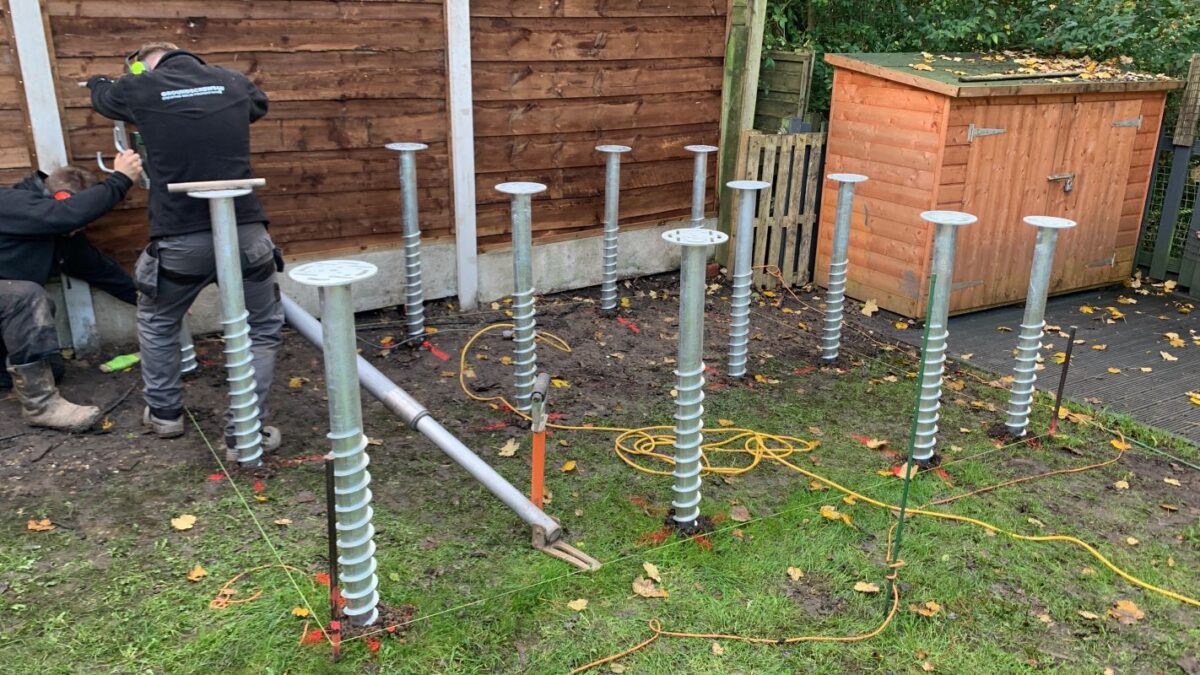Choosing the right foundation is an important decision when building a garden room – as the sayings go, foundations are key to everything else.
You won’t be able to see them when the room is complete but solid foundations will support the weight of your garden room, keep it level and protect it from shifting or sinking over time – yes, garden rooms need foundations.
The right foundation also impacts how quickly your garden room can be built, how much it costs and how much impact it has on the environment. But which foundation type is better: concrete or ground screws?
Both options have their advantages, but here at Lux Garden Rooms, we’re big fans of ground screws. They’re modern, more environmentally friendly and much quicker to install than concrete.
This short guide will take a closer look at both foundation types, compare their pros and cons and help you decide which is best for your project.

Concrete vs Ground Screws: Quick Comparison
Here’s a quick comparison of how concrete and ground screws stack up:
| Feature | Concrete Foundations | Ground Screws |
| Installation time | Several days (incl. curing) | A few hours |
| Environmental impact | High emissions, intrusive | 60% lower emissions, minimal impact |
| Cost | Higher (materials + labour) | Lower overall costs |
| Durability | Long-lasting | Long-lasting, corrosion-resistant |
| Weather flexibility | Limited (needs dry weather) | Can be installed year-round, even in frozen soil |
| Reusability | Permanent, not reusable | Reusable and recyclable |
While ground screws are generally more cost-effective, the overall cost will also depend on your garden room design and other materials used. Find out how much a garden room costs to plan your budget effectively.
How concrete foundations work
Concrete foundations have been the go-to choice for decades. They provide a strong, stable base for your garden room – there’s no doubt about that – but the process can be time-consuming, disruptive and messy.
The concrete process begins by excavating the ground to create a level base for the foundation. Once the area is dug out, a layer of gravel or compacted hardcore is added to provide stability and improve drainage.
Wooden or metal boards, called formwork, are then placed around the edges of the site to hold the concrete in place. For larger or heavier garden rooms, steel reinforcement may be added to strengthen the foundation. Finally, the concrete is poured and levelled using tools like screeds to create an even surface.
Once poured, the concrete must be left to cure and harden, which can take up to several days depending on the weather and the size of the foundation.
When to choose concrete foundations
Concrete may still be a good option in certain situations:
- If you’re building a very large or heavy garden room
- If you already have a pre-existing concrete slab in place
- When you need a permanent foundation and don’t mind the time or cost involved
Pros of concrete foundations
- Strong and durable, making them ideal for heavier structures
- Can provide excellent stability on uneven ground when properly prepared
Cons of concrete foundations
- High environmental impact – cement production is a major source of carbon emissions
- Installation takes longer
- Requires significant digging, which can disrupt your garden and create a lot of mess
- Can be more expensive

Ground screws – A modern, more sustainable alternative
Ground screws, sometimes called helical screws or screw piles, are becoming a popular choice for garden room foundations – we’ve certainly seen the trend and it’s easy to see why.
Unlike traditional concrete foundations, ground screws are installed directly into the ground without the need for digging or pouring concrete. This makes them a cleaner, faster and a much more sustainable option.
Once installed, you can build any type of garden room you want – see our garden room ideas post for more inspiration.
How ground screws work
Ground screws are large, steel screws that are driven into the ground using specialised equipment. When enough are used, they act as anchors to create a strong and stable foundation for your garden room.
Because they’re inserted directly into the soil, there’s no need to excavate, compact or pour anything like you would with concrete. This makes the installation process far less disruptive and in our opinions, much more preferable. There are also no issues with planning permission or building regs.

Key benefits of ground screws
- Fast installation – Ground screws can be installed in a matter of hours, which is up to 70% quicker than the process for laying concrete. There’s no waiting for concrete to set, so you can move on to building your garden room straight away.
- Strong load capacity – Ground screws can handle heavy loads when installed correctly and to the right depth. This makes them suitable for a wide range of garden room sizes, from small studios to larger structures.
- No digging or mess – Unlike concrete, which requires excavation, ground screws are installed with minimal disruption to your garden. There’s no need to worry about rubble, mixing concrete, or uneven ground.
- Year-round installation – Ground screws can be installed in all weather conditions—even in frozen soil. This makes them a flexible option for projects during the colder months.
- Durability – Made from high quality, robust steel, ground screws are rust and corrosion resistant. They are designed to last for many, many decades without any deterioration in structural integrity.

A closer look at the environmental impact of foundations used
When choosing between concrete and ground screws, the environmental impact is an important consideration for many.
Concrete production is energy-intensive and releases a significant amount of carbon dioxide into the atmosphere. The primary ingredient, cement, is responsible for 8% of global CO2 emissions, making it one of the most polluting industries worldwide.
In addition to this, concrete relies heavily on sand, which is the second most traded commodity on earth after water. The high demand for sand has led to unsustainable mining practices, damaging ecosystems and landscapes.
And this process of disrupting the environment continues on a local front. The process of digging and laying concrete foundations disturbs soil, plant life and local habitats. Once concrete is in place, it’s permanent and cannot be removed or reused.

Why ground screws are more sustainable
Ground screws are a far more eco-friendly choice. According to Stop Digging, ground screws reduce carbon emissions by up to 60% compared to concrete foundations. Here’s why they’re better for the planet:
- Minimal disturbance – Ground screws are installed without excavation, preserving the soil and surrounding ecosystem. There’s no need to disturb plant roots or compact the earth.
- Recyclable materials – Ground screws are made from stainless steel, which is one of the most recyclable materials in the world. In the UK, approximately 96% of stainless steel used in construction is recycled. In fact, according to the International Stainless Steel Forum, 80% of all new stainless steel is made from recycled stainless steel and electricity.
- Reduced carbon footprint – Stainless steel ground screws can be produced using electricity and recycled steel (which has no reduction in quality or structural strength). This greatly reduces their CO2 emissions. For example, producing stainless steel with 50% recycled content reduces emissions by over 50% compared to using raw materials.

Why we choose ground screws
Here at Lux, we believe ground screws are the best foundation option for most garden rooms. They’re not only faster and easier to install, but they also align with our commitment to sustainability. By avoiding the need for concrete, we reduce our environmental impact while delivering a high-quality foundation for your project.
Our team is also adaptable to your specific needs, whether that means using existing concrete slabs or finding the best solution for your site. Contact us today to find out more about our foundation options and how we can help with your garden room project.
You can also see our garden room gallery and prices here.
FAQs
1. What is the 2.5m rule for garden rooms?
The 2.5m rule means that if your garden room is built within 2 metres of your property boundary, its height cannot exceed 2.5m to comply with permitted development regulations. You can read more about garden room planning permission here.
2. Can ground screws support large garden rooms?
Yes, ground screws can handle significant weight and often match or exceed the load-bearing capacity of concrete.
3. Are ground screws suitable for all soil types?
Ground screws work in most soil types, including clay, sand and rocky terrain. However, very loose or rocky soil may require additional support.
4. How long do ground screws last?
Ground screws are made from stainless steel, which resists rust and corrosion. When properly installed, they can last for decades, often outlasting concrete foundations.
5. Are garden rooms cheaper than an extension?
Garden rooms are a versatile and cost-effective alternative to traditional home extensions, often coming in around 50% cheaper than your equivalent extension. Read more about whether a garden room is cheaper than an extension.

